How to DOP? – Selection & Implementation
Choosing a Digital Operations Platform
While there are many factors to consider when choosing a DOP, businesses should prioritize their specific needs and goals to make the right decision. It is also important to involve all relevant stakeholders in the decision-making process to ensure buy-in and successful adoption of the platform.
Size and complexity of operations
Businesses with large and complex operations require a DOP that can handle a high volume of transactions and support various workflows. A scalable and flexible platform can ensure that the DOP can adapt to changing business needs.
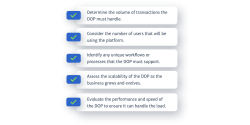
Budget
The cost of implementing a DOP can vary widely, so businesses must consider their budget and look for a platform that offers a good balance between features and affordability. It is important to consider the total cost of ownership, including implementation, training, and ongoing maintenance.
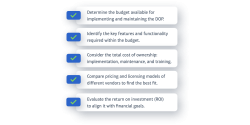
Existing technology stack & Integrations
The DOP should integrate seamlessly with existing systems, such as enterprise resource planning (ERP) and customer relationship management (CRM) platforms, to ensure a holistic view of the business. Integration capabilities can also help reduce manual intervention and improve operational efficiency.
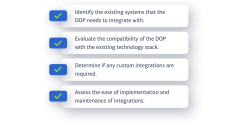
Vendor support
Choosing a vendor that offers comprehensive support and training is essential to ensure a successful implementation and adoption of the DOP. A vendor with a strong track record of customer support can provide the necessary guidance and expertise to help businesses achieve their goals.
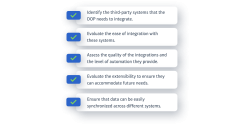
Tip: RFP
TIP: A Request for Proposal (RFP) can be a helpful tool for businesses in the process of choosing a Digital Operations Platform (DOP). An RFP is a document that outlines the business’s requirements and asks potential vendors to submit proposals that meet those requirements. The RFP process can help businesses identify vendors that offer the features they need and ensure that the vendor understands the business’s specific needs. It can also help businesses compare proposals from different vendors and evaluate them based on factors such as cost, implementation timeline, and vendor support. By using an RFP, businesses can make an informed decision about which DOP to choose and ensure that the platform meets their specific needs.
While there are many factors to consider when choosing a DOP, businesses should prioritize their specific needs and goals to make the right decision. It is also important to involve all relevant stakeholders in the decision-making process to ensure buy-in and successful adoption of the platform.
Implementing a Digital Operations Platform
Implementing a digital operations platform (DOP) can be a complex and challenging process for any business. It requires a significant amount of planning, coordination, and collaboration between different teams and stakeholders. Here are some key steps that businesses can take to ensure a successful implementation of a DOP:
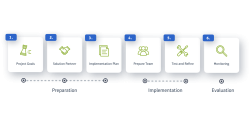
Step 1: Define project goals and objectives
The first step in implementing a DOP is to clearly define the project goals and objectives. This includes identifying the specific pain points and challenges that the DOP will address, as well as the desired outcomes and benefits. It’s important to involve all stakeholders, including IT, operations, finance, and management, in this process to ensure alignment and buy-in.
How Marello helps: Our team works closely with businesses to identify their specific pain points and challenges, and to determine the desired outcomes and benefits of implementing Marello. By involving all stakeholders in this process, we can ensure alignment and buy-in from the entire organization.
Step 2: Choose the right implementation partner
Choosing the right implementation partner is crucial to the success of a DOP implementation. This includes selecting a vendor with a proven track record of successful implementations, as well as a deep understanding of the business’s industry and specific needs. It’s important to evaluate vendors based on factors such as experience, expertise, support and training offerings, and pricing.
How Marello helps: As the creators of Marello, we are uniquely qualified to help you find the right implementation partner for businesses looking to adopt our platform. We have many qualified partners with a proven track record of successful implementations, and deep expertise in a wide range of industries and business needs.
Step 3: Develop a detailed implementation plan
Once the implementation partner has been chosen, the next step is to develop a detailed implementation plan. This should include a timeline, milestones, and specific tasks and responsibilities for each team member involved in the implementation. It’s important to ensure that the plan is realistic and achievable and that it takes into account any potential roadblocks or delays.
How Marello helps: Our team, and our solution partners, work closely with businesses to develop a realistic and achievable implementation plan, including a timeline, milestones, and specific tasks and responsibilities for each team member involved in the implementation.
Step 4: Prepare the business and team
To ensure a successful implementation, it’s important to prepare the business and team for the change. This includes providing adequate training and support to team members who will be using the DOP, as well as communicating the benefits and goals of the DOP implementation to the wider organization. It’s also important to address any potential concerns or resistance to change and to involve all stakeholders in the implementation process.
How Marello helps: We provide comprehensive training and support to ensure that all team members who will be using Marello are fully prepared for the change. We also communicate the benefits and goals of the implementation to the wider organization and work to address any potential concerns or resistance to change.
Step 5: Test and refine the DOP
Before going live with the DOP, it’s important to thoroughly test and refine the system. This includes testing all functionality, workflows, and integrations, as well as identifying and addressing any bugs or issues. It’s also important to gather feedback from users and stakeholders and to make any necessary adjustments or refinements to the system before going live.
How Marello helps: our partners and our team conduct thorough testing of all functionality, workflows, and integrations to ensure that Marello meets the specific needs of each business.
Step 6: Monitor and evaluate the DOP
After the DOP is live, it’s important to continuously monitor and evaluate its performance and impact on the business. This includes tracking key metrics such as transaction volume, order accuracy, and customer satisfaction, as well as identifying any areas for improvement. It’s also important to maintain open communication with the implementation partner and vendor and to ensure that the system remains up-to-date and relevant to the business’s needs over time.
How Marello helps: As part of our customer success program, we work with businesses to track key metrics such as transaction volume, order accuracy, and customer satisfaction, and to identify areas for improvement. We maintain open communication and support to ensure that the system remains up-to-date and relevant to the business’s needs over time.
Implementing a DOP can be a significant investment of time, resources, and effort for any business. However, by following these key steps, businesses can ensure a successful implementation that delivers real benefits and value to the organization.
In conclusion
In conclusion, implementing a Digital Operations Platform (DOP) can provide numerous benefits for businesses of all sizes and industries. With its ability to streamline operations, increase efficiency, and improve customer satisfaction, a DOP can be a game-changer for businesses looking to stay ahead in today’s digital landscape. However, choosing the right DOP and implementing it successfully can be a complex process that requires careful consideration, planning, and collaboration with the right vendor and implementation partner.
Ultimately, the key to a successful DOP implementation is to align the technology with the business’s goals, needs, and culture, and to involve all stakeholders in the process. By doing so, businesses can realize the full potential of a DOP and drive their digital transformation forward.
If you’re interested in learning more about how Marello DOP can help your business, please don’t hesitate to contact us. Our team of experts is ready to answer any questions you may have and help you get started on your journey to digital transformation with a DOP.
Retour au blog